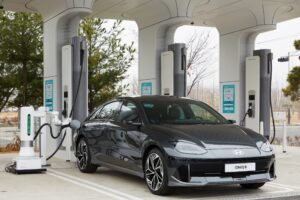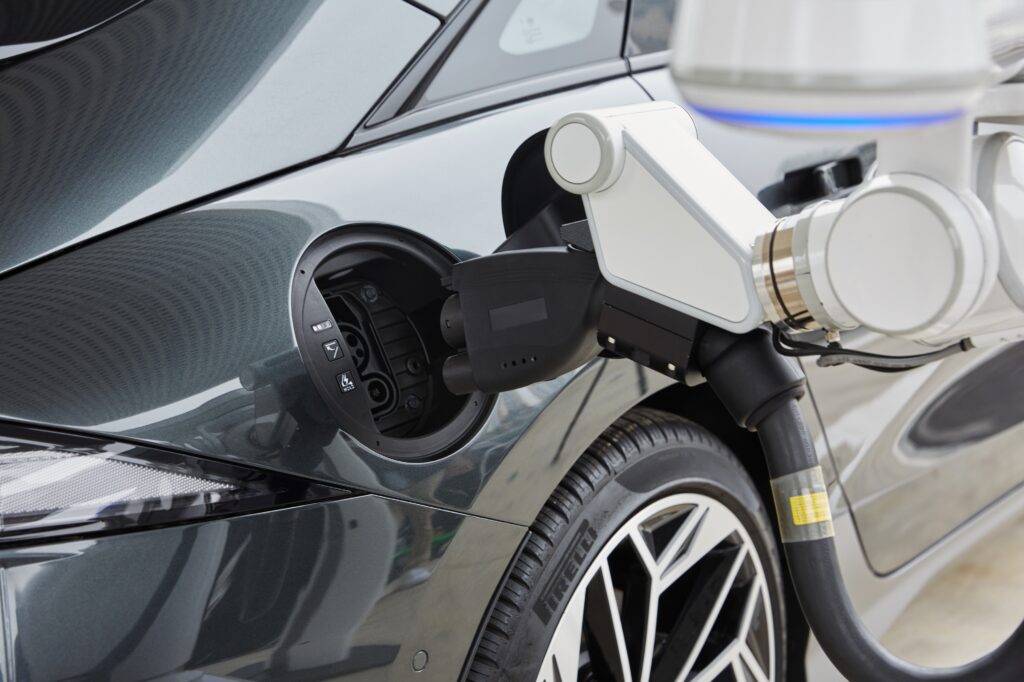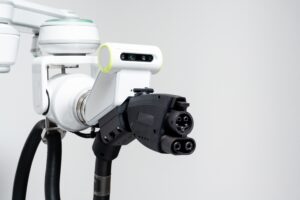
Hyundai develops futuristic, one-armed charging robot for EVs
By onAnnouncements
Hyundai says it has developed automatic charging robots that can autonomously connect to electric vehicles (EV).
The automaker said it predicts machines will “support humans with EV charging in [the] near future,” and designed the automatic charging robot (ACR) to open vehicle charging ports and plug chargers in.
The technology, which Hyundai said can be used in all environments and weather conditions, will be introduced to the public March 31 through April 9 during the 2023 Seoul Mobility Show.
“The ACR will help to make EV-charging easier and more convenient, especially in dark environments. It will also improve accessibility, particularly for people with mobility barriers, as charging cables become thicker and heavier to enable high-speed charging,” said Dong Jin Hyun, head of Hyundai’s robotics lab. “We will continue developing the ACR for increased safety and more convenience, so that all EV customers can soon benefit from using it at charging stations.”

The one-armed robot connects to the port through control technology equipped with a 3D camera-based artificial intelligence algorithm.
Hyundai also released a video this month showing the technology’s capabilities. It shows a Hyundai IONIQ 6 parking autonomously in an EV charging station.
Once the SUV is parked, the ACR gets to work communicating with the vehicle to open the charging port and determining the right location with assistance from a camera mounted inside the port.
“The robot then picks up the charger and fastens it to the vehicle’s charging port, thus starting the charging session,” Hyundai said in a press release. “Once charging is complete, the robot removes the charger, returns it to its rightful place, and closes the cover of the vehicle’s charging port.”
The OEM said the ACR is just one example of its advancements in robotics technology.

Late last year, Hyundai broke ground on its first U.S. EV and battery manufacturing plant in Georgia, where robots will assist human workers.
Also last year, the OEM announced that it plans to transform its entire lineup to software defined vehicles (SDVs) by 2025, allowing over-the-air (OTA) upgrades of safety, convenience, connectivity, security, driving performance, and other functions.
The OEM said its strategy, announced Wednesday during Hyundai Motor Group’s Unlock the Software Age global online forum, will give customers “the freedom to remotely upgrade the performance and functionality of their vehicles anywhere at any time.”
Other automakers are exploring taking futuristic technologies even further.
BMW said this month that its head-up display (HUD) called BMW Panoramic Vision will go into production in 2025 with the first Neue Klasse models including a sports activity vehicle and 3 Series sedan.
Neue Klasse, referring to BMW’s 1960s models, is the OEM’s new technology platform that is currently in development that will set new standards in digitalization, sustainability, and design for electric vehicles (EVs), according to a BMW news release.
The HUD will project across the entire width of the windscreen and create a unique interaction and information surface for all occupants.
“The windscreen becomes a single large display with our new BMW Panoramic Vision, opening up completely new possibilities for the design of our vehicles,” said Frank Weber, BMW AG Board for Development member. “The driver decides which information they want to display in their own field of vision, or that all occupants can see the entire content. The revolutionary projection and the significantly more clearly structured cockpit give an impressive new feeling of space and driving. We are taking our proven ‘eyes on the road-hands on the wheel’ commitment to a new level.”
The display will show relevant information for both the driver and passengers with higher light intensity and contrast onto a dark-coated area at the lower edge of the windscreen. BMW says this will create an extremely sharp image that is always visible across the full width of the windscreen.
On-board computers with digital displays first appeared in the BMW 7 Series in the 1980s. The first BMW iDrive in 2001 reduced the number of switches and buttons like no other control system before, creating a modern, uncluttered interior, the release states. The first series production of BMW HUD displays followed shortly after.
BMW has also unveiled its i Vision Dee — a fully EV with a voice, facial expressions, and “true personality” — at the Consumer Electronics Show (CES) in Las Vegas earlier this year. Along with the extended HUD, the OEM showed how i Vision Dee can be used for display control design and an immersive user experience in the future.
“The study demonstrates the fusion of reality and the virtual world by turning the windshield into a projection surface,” the release states. “This technology will now become reality in series production with the Neue Klasse with the introduction of the BMW Panoramic Vision.”
Meanwhile, Ford is trying to patent a technology that could allow its cars to autonomously drive themselves back to dealerships if the owners default on payments.
The OEM’s application, published last month by the U.S. Patent Office, was first reported by Gizmodo.com, which called it “an unsettling peek into an alternate universe where private companies have even more say over our day-to-day lives.”
The patent, called “Systems and Methods to Repossess a Vehicle”, describes how onboard computer systems could be linked to a separate computer controlled by the lender and used to remotely call back defaulted cars.
A driver late on payments would initially receive a “notice of delinquency” through the system and, if they ignore it, could soon start losing access to features such as music, automated door locks, or air conditioning.
Images
Featured image credit: Hyundai Motor Group
Automatic recharging robot photos (Credit: Hyundai Motor Group)
